Neutering is an important and routine surgical procedure for dogs, helping to control the pet population and prevent certain health issues.
While most dog owners are well-informed about the recovery process after neutering, there’s one common question that often arises: “How soon can I bathe my dog after neutering?”
It’s a valid concern, as maintaining your furry friend’s hygiene is crucial, but timing is key to ensure a smooth and comfortable recovery.
In this article, we’ll explore the factors that determine when it’s safe to give your dog a bath post-neutering and provide you with some valuable insights to keep your canine companion healthy and happy during this crucial time.
What is Neutering and Why is it Important?

Neutering is a surgical procedure that removes the reproductive organs of your dog, either partially or completely. It is also known as spaying for females and castration for males. Neutering your dog has many advantages, such as:
- Reducing unwanted behaviors, such as aggression, marking, roaming, mounting, or barking.
- Preventing diseases, such as cancer, infections, or hormonal disorders.
- Controlling overpopulation, which reduces the number of homeless or euthanized dogs.
Neutering your dog is usually done between 6 and 9 months of age, but it can vary depending on the breed, size, and health of your dog. Your vet will advise you on the best time and method for your dog.
How to Care for Your Dog After Neutering?
After neutering your dog, you need to follow some basic guidelines to ensure a smooth and speedy recovery. Some of the things you should do are:
- Monitor the incision site regularly for any signs of swelling, redness, bleeding, or discharge. If you notice any of these symptoms, contact your vet immediately. You can use a portable dog washer to gently clean the area around the incision.
- Restrict your dog’s activity for at least 10 days after the surgery. Avoid running, jumping, playing, or climbing stairs. Keep your dog in a quiet and comfortable place, away from other pets or children.
- Follow the vet’s instructions regarding pain medication, antibiotics, or anti-inflammatory drugs. Do not give your dog any human medication without consulting your vet first.
- Prevent your dog from licking or biting the wound. You may need to use an Elizabethan collar (also known as a cone) or a surgical suit to protect the area.
- Feed your dog a bland diet for the first day after the surgery. Avoid giving your dog any treats, bones, or raw food. Gradually resume the normal diet over the next few days.
When Can You Bath Your Dog After Neutering?
The answer to this question depends on several factors, such as the type of surgery, the healing process, and the risk of infection. In general, you should wait at least 10 to 14 days after neutering before bathing your dog. This is because:
- The incision site needs time to heal and form a scab. Wetting or soaking the wound can delay the healing process and cause irritation or infection.
- The stitches or staples used to close the wound are not waterproof. They can dissolve or come loose if exposed to water or moisture.
- The anesthesia used during the surgery can affect your dog’s body temperature regulation. Bathing your dog too soon can cause hypothermia or overheating.
However, there may be some exceptions to this rule. For example:
- If your dog has a non-invasive surgery, such as laparoscopic or laser neutering, you may be able to bathe your dog sooner than 10 days. This is because these methods use smaller incisions and less tissue damage.
- If your dog gets dirty or smelly due to an accident or illness, you may need to bathe your dog before 10 days. In this case, you should consult your vet first and follow their advice on how to clean your dog safely.
What to Avoid When Bathing Your Dog After Neutering?

When bathing your dog after neutering, you should be careful not to cause any harm or discomfort to your dog. Some of the things you should avoid are:
- Using harsh products, such as shampoos, soaps, detergents, or perfumes. These can irritate or dry out your dog’s skin and coat. Use only mild and gentle products that are specially formulated for dogs.
- Rubbing or scrubbing the wound area. This can damage the tissue and cause bleeding or infection. Use only a soft cloth or sponge and gently wipe around the wound.
- Exposing the wound to water or heat. This can soften the scab and increase the risk of infection. Use only lukewarm water and avoid using hair dryers or heaters.
- Bathing your dog too frequently or for too long. This can strip away the natural oils and moisture from your dog’s skin and coat. Bathe your dog only when necessary and for no more than 10 minutes.
Read the related article: How To Make Your Dog Smell Good Without a Bath
How to Make Bathing Your Dog After Neutering a Positive Experience?
Bathing your dog after neutering can be a stressful and unpleasant experience for both you and your dog. However, there are some ways to make it more enjoyable and rewarding. Some of the things you can do are:
- Use treats, toys, praise, or gentle massage to reward your dog for being calm and cooperative. This can help your dog associate bathing with something positive and fun.
- Choose a comfortable and familiar place to bath your dog, such as your bathroom, bathtub, or sink. This can help your dog feel more secure and relaxed.
- Use a non-slip mat, towel, or blanket to provide traction and support for your dog. This can prevent your dog from slipping or falling and hurting themselves.
- Talk to your dog in a soothing and reassuring voice. This can help your dog feel more confident and trusting.
Well, That’s a Wrap
In conclusion, the timing of bathing your dog after neutering is an essential consideration to ensure their comfort and well-being during the recovery process. It’s generally best to wait for at least a week or as advised by your veterinarian to allow the surgical site to heal properly.
Prioritize their hygiene and use gentle, vet-approved products when you do decide to bathe them. Always consult with your veterinarian for specific guidance tailored to your dog’s unique needs.
By being patient and attentive, you can help your furry friend recover smoothly and return to their playful, happy self in no time.

